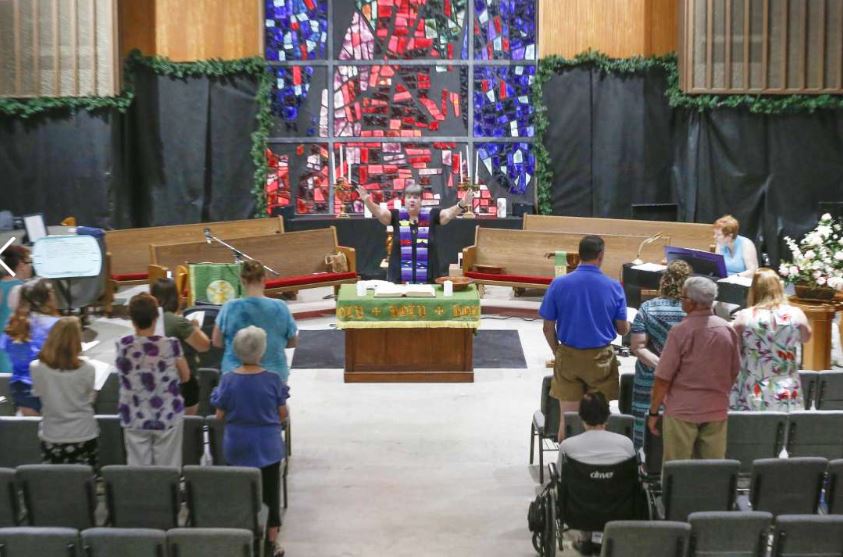by Maggie Gordon, Houston Chronicle
 For years, when Rev. Kathy Sebring stood at the lectern, preparing to give her Sunday morning sermon, she’d face rows and rows of pews. Some would be empty.
For years, when Rev. Kathy Sebring stood at the lectern, preparing to give her Sunday morning sermon, she’d face rows and rows of pews. Some would be empty.
The pews are gone. So are the floors they were bolted down into. And the walls? They’re still just studs, as the church awaits FEMA funding to replace the drywall.
A year ago this weekend, Sebring had to call off Sunday morning service for the first time in her memory, texting parishioners, telling them to stay home and stay safe, as Hurricane Harvey’s wild and muddy waters rolled through the small town of Dickinson, inching up the exterior walls at the First Presbyterian Church of Dickinson, before flooding the church’s interior.
Stacks of bibles were flung out on the curb, among a slowly constructed high-rise of debris. The organ that had loomed large at the front of the church for decades was added to the heap. And the pews. The floors. At first glance, the lawn – where the congregation worshiped under tents for the first few weeks after the storm – looked like a receptacle for all the tattered pieces that come together to make a church.
Except it wasn’t. Not really.
“Last week, we read that Solomon was building a temple after his father died,” Sebring said on Sunday morning, as a dozen parishioners – about a fifth of the church’s total membership – sat listening intently. “The temple is mentioned in the scripture, but it’s not around anymore.”
She paused for a moment.
“I mean, things happen to buildings,” she said. “But we as a people of God are in a covenant relationship with God, and we need to be reminded, as we were a year ago, that we are the church. Not our building. We hope and pray we’re going to be able to bring it back around. But the building is not the church. We are.”
Out in the front row, LuAnn Ash sat listening intently. Ash was one of many members of this small congregation that had to evacuate her home during Harvey. She packed up her two cats and hitched a boat ride to safety, courtesy of a neighbor, who helped her find space in one local shelter, then another, where she stayed for a total of four days.
“This church has been so strong and steady through it all, even through all the damage we got,” said Ash, who pitched in to help with the church’s relief drives in the days and weeks following Harvey. It gave her something to do. Familiar faces to keep her world steady. A chance to stand near the large stained-glass cross at the very front of the church – the decorative beacon that first drew her to First Presbyterian. “I can’t tell you what this church means to me.”
A few months ago, she attended a funeral service at a church in Texas City.
“We didn’t realize how much we missed things like soap in the bathroom and a mirror until then,” she said, laughing. There is soap in the bathroom at First Presbyterian now, and working toilets again – finally. “It makes you think: It might have been pretty there, but this is home.”
It’s a home that Dian Groh has considered leaving more than once in the dozen years since she joined the church. Somehow, the gravitational pull of the church’s community always brings her back though.
“I feel like God is here,” she said, tearing up. “I’ve tried to leave this church. But I can’t. I go to other churches with my daughter, and it just doesn’t feel the same. So here I am. Bare walls, doesn’t matter. It doesn’t feel any different here – it just looks different.”
When Groh lost everything in her one-story home not far from the church, it was the members of her church who rallied together to pitch in.
“Harvey was a tragedy in some ways, but also a blessing. So many helped, it was just amazing,” she said.
Even in the midst of such chaos, she saw light. And never once felt alone.
